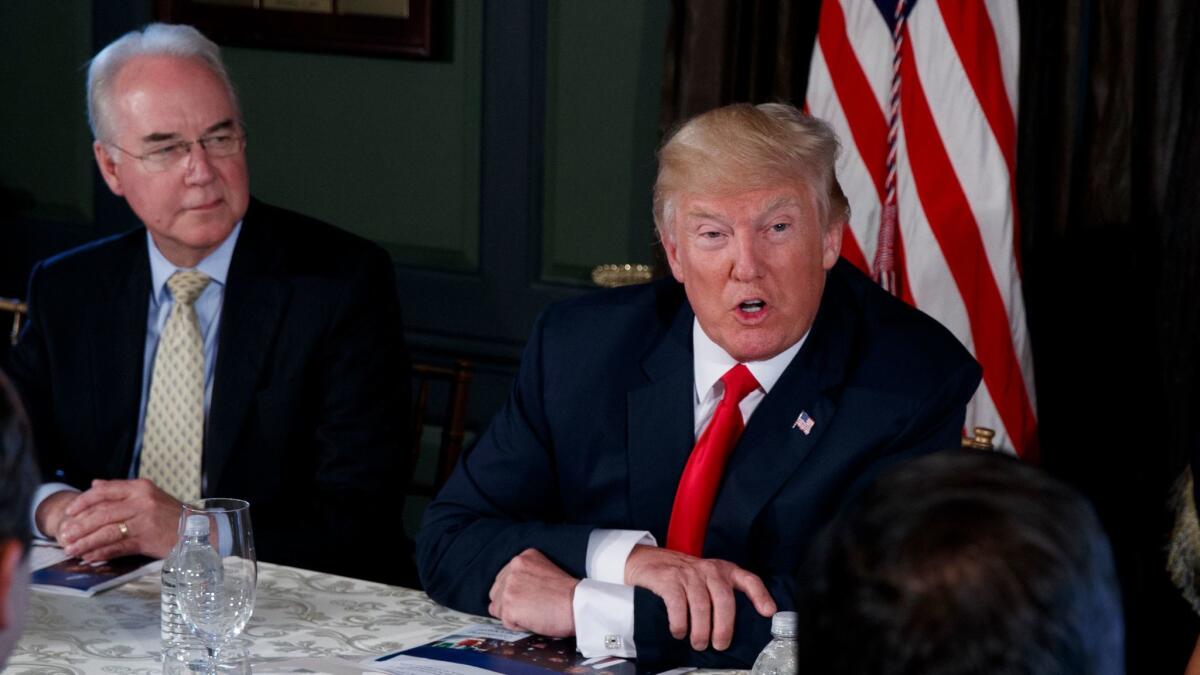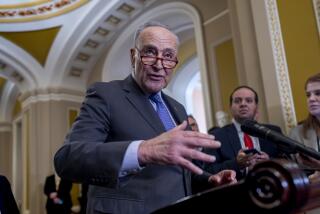Trump administration agrees to continue healthcare subsidy for now

Washington — The Trump administration, faced with increasing pressure from Republican members of Congress, backed away from causing an immediate crisis in healthcare marketplaces and agreed Wednesday to continue making payments to insurance companies that are widely viewed as critical to keeping the industry stable.
President Trump and his top aides have flirted for months with cutting off the money, known as cost-sharing reduction payments, which help subsidize insurance co-payments and deductibles for low-income and moderate-income Americans. Doing so would be one step toward causing the Affordable Care Act to “implode” — as Trump has sometimes put it.
The decision to make this month’s payment, due next week, signaled that the administration has decided against immediately precipitating a collapse, potentially giving Congress time to pass a bipartisan package of fixes to some of the law’s problems.
Leading Republican members of Congress have pressed the administration to keep making the payments, fearing that any move to cut them off would cause chaos in insurance markets. Trump has said voters would blame Democrats for any problems with the markets, but few Republican elected officials share that view.
The pressure to continue the payments increased Tuesday when the Congressional Budget Office reported that cutting off the payments would actually increase federal spending. Ending them would cause insurance premiums to rise sharply and thereby increase the cost of other government subsidies, the budget office said.
A White House official confirmed Wednesday that the administration had decided to make this month’s payment, which will total about $600 million. The question of whether to make future payments remains under review.
The announcement drew praise from Sen. Lamar Alexander (R-Tenn.), the head of the Senate committee that handles healthcare legislation.
The decision to continue the subsidies “helps 18 million Americans who … don’t get insurance from the government or on the job,” Alexander said in a statement.
When Congress returns from its recess in September, lawmakers should quickly pass legislation that would continue the payments through next year, Alexander said.
The continuation should be linked to changes in the current law to “give states more flexibility” on the kinds of insurance policies that consumers can buy, he added.
But some conservative lawmakers and organizations were quick to voice their displeasure, calling the payments a “bailout” of insurance companies.
That opposition illustrated the difficulty Alexander and like-minded lawmakers will face in trying to round up Republican support for legislation to stabilize a healthcare law the party has long wanted to repeal.
And if Congress does not quickly settle the issue, the continued month-to-month uncertainty about the payments is likely to cause insurers to hike premiums.
Already, industry executives have publicly blamed the uncertainty for higher premiums for next year. Insurers are coming up on deadlines next month for setting their premiums for next year’s open enrollment period.
The part of the healthcare law at issue greatly lowers the cost of insurance for millions of low- and middle-income consumers by requiring insurers to hold down deductibles and co-payments.
That requirement can save thousands of dollars for families with big medical bills who can qualify for the cost reductions if their incomes are below about 2½ times the federal poverty level.
The requirement to hold down co-payments and deductibles, however, costs insurance companies a lot of money. To make them whole, the government reimburses them with the monthly payments.
Since early this year, the administration has refused to commit to continue sending the checks.
In late July, after Republicans failed in their effort to repeal the healthcare law, Trump said that he wanted to “let Obamacare implode.” An abrupt cutoff of the cost-reduction payments would be among the quickest ways to make that happen.
The cost-sharing reductions have long been a controversial part of the healthcare law.
Republican lawmakers went to court in 2014 to challenge the payments, saying Congress had never appropriated money for them. A federal district judge in Washington agreed last year. The Obama administration appealed, and the ruling has been on hold ever since.
At one point, Trump administration officials talked of dropping the appeal as a way to kill the payments. That option faded this month after Democratic state attorneys general won the right to intervene in the case, which would allow them to keep the appeal alive if Trump pulled out.
Although many of Trump’s advisors oppose the payments, the budget office report Tuesday put them in a difficult position.
The report from the nonpartisan budget office said that cutting off the payments would have paradoxical effect of increasing federal spending.
That’s so because insurers would still be required to hold down deductibles and co-payments for low- and moderate-income consumers. To avoid losing money, some insurers would pull out of the marketplaces. Most, however, would raise premiums, the budget office projected.
The premiums for the medium-cost silver plans on the exchanges, which are the most popular plans among consumers, would go up by about 20% to 25% over the next couple of years if the cost-sharing payments ended, the budget office said.
The cost of those higher premiums would land primarily on taxpayers, not on individual consumers. That’s because nearly 80% of people receiving coverage on the marketplaces also receive a second kind of government assistance to help pay monthly premiums. As overall premiums rise, so will the cost of those other government subsidies.
The net result would be to increase the federal deficit by almost $200 billion over the next 10 years, the budget office said.
If the subsidy payments were ended, insurers pulling out of the market would leave about 5% of the population in counties with no marketplace insurer, the budget office also projected.
For more on Politics and Policy, follow me @DavidLauter on Twitter.
ALSO
Who was responsible for the violence in Charlottesville? Here’s what witnesses say
Latest crisis on North Korea eases as both sides pull back — for now
Get the latest news from the nation’s capital on Essential Washington >>
UPDATES:
3:25 p.m.: This article was updated with additional detail and reaction.
The article was originally published at 1:55 p.m.
More to Read
Get the L.A. Times Politics newsletter
Deeply reported insights into legislation, politics and policy from Sacramento, Washington and beyond. In your inbox three times per week.
You may occasionally receive promotional content from the Los Angeles Times.











